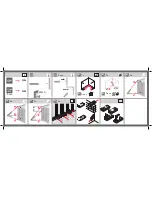
15
Digital Inputs – AES3id (S/PDIF)
The 744T accepts AES3id and S/PDIF unbalanced digital signals at the BNC connectors. The 744T
will auto detect the type of digital signal and adjust accordingly. Input signals are in pairs, signals on
BNC 1 appear at inputs 1 and 2, signals on BNC 2 appear at inputs 3 and 4.
AES3id inputs override analog signals present at the XLR inputs. To input analog audio while using
the AES3id signal as a digital clock source, you must select analog in the input source menu selection
for the appropriate inputs.
When a digital signal is present, the 744T will lock its sampling rate to the source frequency. This is
indicated by a highlighted block on the main LCD display to the right of the bit depth and sam-
pling rate indicators. Recording bit depth is not affected by the external digital source.
If you are locking the 744T to an external digital signal, be certain the source is stable. Loss of the
digital signal will cause the 744T to revert to its internally set sampling rate, even while recording.
The portion of the file recorded after the loss of signal may not play back properly. Once recording
has begun, unused digital inputs are muted, digital signals that appear on them after the record key
has been pressed will not be recorded or affect the sampling rate of the 744T.
The 744T clocks itself to the first digital signal presented to it. If the 744T detects a digital signal on the
BNC inputs and locks to that signal, a digital signal applied to the XLR input will be ignored until the
first digital signal is removed.
Signal Presence and Peak Indicator
The four signal presence and peak indicators show audio activity before input-to-track
routing. Input signal presence LED’s illuminate when a –50 dBFS or greater signal is present. Input
signal peak LEDs illuminate when signal levels reach –3 dBFS or greater.
Input Delay
A digital delay is selectable on each channel of the 744T. Delay time per input is selectable in tenths
of a millisecond (0.1 msec) steps. The Rotary Switch and menu arrows are accelerated. The more you
press or spin, the faster the time setting will increase or decrease. Delay is not set until the Rotary
Switch is pressed or or the check mark is selected. The amount of delay available is dependent on the
sampling frequency in use.
Sample Frequency
Maximum Amount of Delay Available (per input)
32, 44.1, 47.952, 48, 48.048 kHz
30 mS
88.2, 96, 96.096 kHz
15 mS
176.4, 192 kHz
7.5 mS
Input delay can be useful for time aligning input signals from differing sources. For example, digital
wireless mics that have a processing delay in their outputs. In addition, all digital conversion stages
have delay.
Summary of Contents for 744T
Page 2: ...backside front cover ...
Page 6: ......
















































